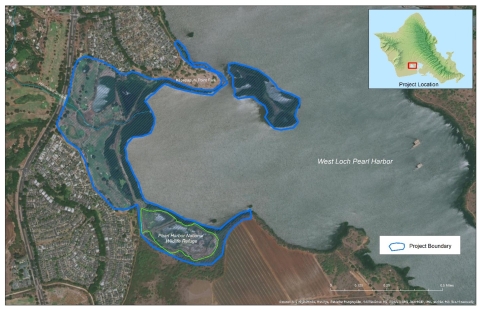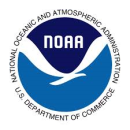States
HawaiiEcosystem
Coastal, WetlandNEWS
- News Release: U.S. Fish and Wildlife Service, NOAA, Seek Public Comment for Draft Restoration Plan and NEPA Evaluation for Oahu Sugar Site, Pearl Harbor
- USFWS Proposed Draft Restoration Plan
- NOAA Proposed Draft Restoration Plan
- Other Resources
- Public Comments and Public Meeting
- USFWS Fact Sheet
- FAQs
Background
From 1947 until 1995, Oʻahu Sugar Company, Ltd. (Oahu Sugar), a subsidiary of Kaanapali Land, LLC, and later renamed Oahu Sugar Company, LLC, operated sugar cane fields and associated facilities on land leased from the Department of Defense and U.S. Navy at the Pearl Harbor Naval Complex on Oʻahu. Activities included pesticide storage, mixing, and loading at a pesticide mixing plant near Walker Bay on the Waipiʻo Peninsula between Pearl Harbor’s West and Middle Lochs. In 1997, sampling by the Hawaiʻi State Department of Health indicated that dioxins, pentachlorophenol, and other hazardous substances associated with agricultural practices were present in the terrestrial and coastal environments around the pesticide mixing plant. It was determined that these substances had injured surrounding natural resources, including endangered waterbird habitat. The United States of America, on behalf of the Navy, the Environmental Protection Agency, the Department of the Interior (DOI), and the National Oceanic and Atmospheric Administration (NOAA), filed a complaint pursuant to the Comprehensive Environmental Response, Compensation, and Liability Act (CERCLA) seeking compensation for Natural Resources Damages.
The Proposal
On February 11, 2022, a Consent Decree was entered with the U.S. District Court for the District of Hawaii announcing the reaching of a settlement in which Kaanapali Land, LLC agreed to pay approximately $2.5 million to facilitate the restoration, rehabilitation, or replacement of those natural resources injured by hazardous substances at the Oahu Sugar former pesticide mixing plant site.
Natural resources trustees—in this case the U.S. Department of the Interior, represented by the U.S. Fish and Wildlife Service (USFWS), and the U.S. Department of Commerce, represented by the National Oceanic and Atmospheric Administration (NOAA)—were tasked with assessing, selecting, and implementing projects to support such restoration. After consideration, the trustees are proposing to divide the $2.5 million settlement between two projects, giving approximately $1.25 million to each.
- The first project is the restoration of the Waiawa Unit of the Pearl Harbor National Wildlife Refuge Project, which will address injuries to endangered waterbird habitat. This project is led by USFWS.
- The second project is the West Loch Pearl Harbor Honouliuli Watershed Wetland Restoration Project, which will address injuries to estuarine coastal wetland habitat. This project is led by NOAA.
Restoration Goals
The goal of CERCLA’s Natural Resource Damage Assessment and Restoration (NRDAR) planning process is to identify and select restoration projects that are appropriate to restore, rehabilitate, replace, or acquire the equivalent of natural resources and their services injured or lost as a result of releases of hazardous substances, in this case at the Oahu Sugar pesticide mixing plant site. This USFWS-led Draft Restoration Plan outlines the trustees’ consideration of projects to address injury to core habitat for endangered waterbirds. It proposes improvements to the Waiawa Unit of the Pearl Harbor National Wildlife Refuge, which will enrich such habitat as was injured near the former pesticide mixing plant.
Public Comment
Public participation and review is an integral part of this process, and we are requesting comments on the proposed plan. A copy of the Draft Restoration Plan for the USFWS-led restoration activities in Pearl Harbor’s Middle Loch is available here. Written comments on either or both plans will be accepted for a period of 45 days, from January 13, 2025, to February 25, 2025. The trustees will address public comments and will respond to those comments as part of the Final RP/NEPA Evaluation.
- Public comments on the USFWS plan may be submitted in writing to:
Alicia Hendrix
300 Ala Moana Blvd Rm 3-122
Honolulu, HI 96850 - Or by email to oahusugarnrdar@fws.gov. Please include “Draft RP/NEPA Evaluation for Oʻahu Sugar Site” in the title.
- Public comments on the NOAA plan may be submitted email to nmfs.oahusugar@noaa.gov. Please include “Draft RP/NEPA Evaluation for Oʻahu Sugar Site” in the title.
- A public meeting will be held on January 29, 2025, from 11:00 a.m. to 2:00 p.m. and 5:00 p.m. to 8:00 p.m. at:
Filipino Community Center
94-428 Mokuola St.
Waipahu, HI 96797
FAQs
Q: What is a recovery plan?
A: A recovery plan serves as a road map for species recovery—the plan outlines the path and tasks required to restore and secure self-sustaining wild populations. It is a non-regulatory document that describes, justifies, and schedules the research and management actions necessary to support recovery of a species.
Recovery plans are developed with federal, state, tribal, local governmental, nongovernmental, and other interested parties. If successfully implemented, recovery plans result in a listed species being reclassified from endangered to threatened status, or result in the delisting and removal of the species from ESA protections.
Q: How does the National Environmental Policy Act work?
A: Congress enacted the National Environmental Policy Act (NEPA) in 1969 and President Nixon signed it into law on January 1, 1970. Congress enacted NEPA to establish a national policy for the environment, provide for the establishment of the Council on Environmental Quality (CEQ), and for other purposes. NEPA requires federal agencies to assess the environmental effects of their proposed actions prior to making decisions. The range of actions covered by NEPA is broad and includes:
- making decisions on permit applications,
- adopting federal land management actions, and
- constructing highways and other publicly-owned facilities.
Using the NEPA process, agencies evaluate the environmental and related social and economic effects of their proposed actions. Agencies also provide opportunities for public review and comment on those evaluations.
Q: What benefits can we expect from this restoration work?
A: The Waiawa Unit of the Pearl Harbor National Wildlife Refuge protects, provides habitat for, and aids in recovery efforts for four of Hawai‘i’s endangered waterbirds: ae‘o (Hawaiian stilt, Himantopus mexicanus knudseni), ‘alae ke‘oke‘o (Hawaiian coot, Fulica alai), ‘alae ‘ula (Hawaiian gallinule, Gallinule chloropus sandvicensis), and koloa maoli (Hawaiian duck, Anas wyviliana). It is also important overwintering habitat for migratory birds such as kōlea (Pacific golden plover, Pluvialis fulva) and ‘akekeke (ruddy turnstone, Arenaria interpres). Over the years, salinity levels in the unit have risen, making the habitat less desirable for these birds. The proposed project will include structural modifications to the Waiawa Unit that will reduce the salinity in the wetland. It will also include removal of invasive vegetation. Together, these actions will result in meaningful and resilient modifications to the unit that will restore its ability to support and sustain populations of these unique birds.





